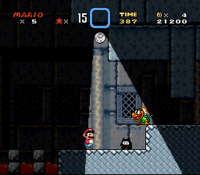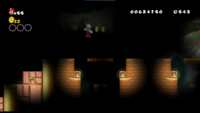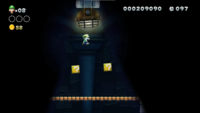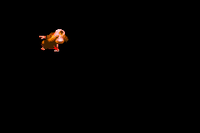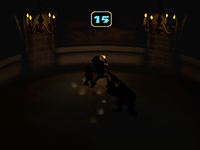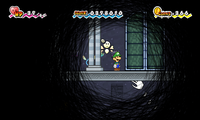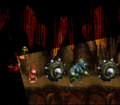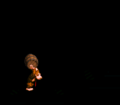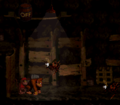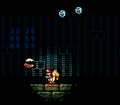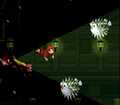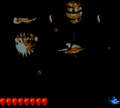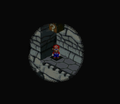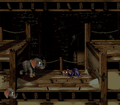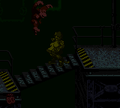Dark
This article is under construction. Therefore, please excuse its informal appearance while it is being worked on. We hope to have it completed as soon as possible.
- "Darkness" redirects here. It is not to be confused with Darkmess.
| Dark | |
|---|---|
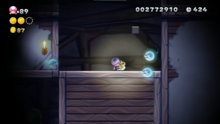 The dark in New Super Mario Bros. U Deluxe | |
| First appearance | Super Mario Bros. 3 (1988) |
| Latest appearance | Super Mario Galaxy + Super Mario Galaxy 2 (2025) |
In the Super Mario franchise, the dark is a recurring obstacle, representing player characters' reduced range of vision in low light.
Player characters and other important entities, such as enemies, coins, and power-ups, often appear lit to remain visible to the player. In this case, the dark mainly obscures the terrain, leaving pits unmarked and making projectiles' trajectories harder to predict. The exact lighting effect used for this has depended on hardware limitations and stylistic considerations. Many games use a spotlight effect.
Emissive objects increase the range of vision in the dark. Some, such as Light Boxes, can also defeat light-sensitive enemies. After touching a Super Star, Invincible Mario illuminates the entire screen, clearing the dark until the invincibility expires.
The dark has a more aesthetic than mechanical effect in some games. For example, in some games in the Mario Kart series, karts' headlights will turn on in dark areas, but the visibility is relatively good regardless.
History[edit]
Super Mario series[edit]
Super Mario Bros. 3[edit]
In Super Mario Bros. 3, the third overworld screen of Dark Land is shrouded in darkness, with only the player's vicinity lit in a circle. In Super Mario Advance 4: Super Mario Bros. 3, this circle expands while the lock on the same screen is undone. Unlike later games, the levels themselves are not darker than expected, aside from exclusively having black backgrounds in the original version.
Super Mario World[edit]
In Super Mario World, the final room of Bowser's Castle before the battle with Bowser is dimly lit. A spotlight below the Item Stock casts a beam of light down across the center of the screen, rocking back and forth. The dark room is accessed directly though the Back Door, with slight alterations from the Front Door layout.
Super Mario Land 2: 6 Golden Coins[edit]
In Super Mario Land 2: 6 Golden Coins, darkness appears in Pumpkin Zone, where it causes certain blocks to fade in and out of visibility.
Super Mario Sunshine[edit]
- “Though it is daytime in Delfino Plaza, our poor residents tremble beaneath a veil of darkness.”
- —Pianta prosecutor, Super Mario Sunshine
A subdued version of darkness appears in Super Mario Sunshine, where it affects Delfino Plaza due to the fleeing of the Shine Sprites. Rather than blackness, it appears as a haze preventing the sunlight from getting through aside from around the Shine Gate. The more Shine Sprites are recovered, the further out the lit area grows until it eventually covers the whole plaza.
Super Mario 64 DS[edit]
In Super Mario 64 DS, darkness is used in the Hide and Boo Seek minigame. The player has to wipe away the darkness to reveal the hidden Boos. This minigame returns in New Super Mario Bros.
New Super Mario Bros. Wii[edit]
The dark occurs in multiple courses in New Super Mario Bros. Wii. It is first present in the main underground area of World 2-3, which demonstrates that it is warded off by the fireballs of Fire Mario, Fire Piranha Plants, Fire Snakes, and Fire Bros, as well as torches in the ground.
Glow Blocks increase the holder's range of vision. They appear in World 2-5, World 5-![]() Ghost House, World 6-6, and World 8-4.
Ghost House, World 6-6, and World 8-4.
World 8-4 introduces bioluminescent enemies: Bulbers and Jellybeams.
Super Mario Galaxy 2[edit]
In Super Mario Galaxy 2, Flash Black Galaxy is pitch-black; a flash of light illuminates the course every eight beats of the background music. Entities that are not part of the terrain proper, such as player characters, items, enemies, and Empty Blocks, are always shown at full brightness. Parts of the background are also dimly lit, which can provide contrast with the pitch-black terrain. However, the back wall of the tower makes this less effective. The Ghost Maze Planet in Boo Moon Galaxy is shrouded in darkness. While on this planet, the player's character illuminates a small portion of the surroundings.
New Super Mario Bros. U / New Super Luigi U / New Super Mario Bros. U Deluxe[edit]
The dark returns in New Super Mario Bros. U, New Super Luigi U, and New Super Mario Bros. U Deluxe, serving as the same visual hazard as in New Super Mario Bros. Wii in all three games. The player(s) are able to temporarily push back the dark with Glowing Baby Yoshis.
Super Mario Maker 2[edit]
In Super Mario Maker 2, dark sub-areas occur with the Underwater (night) and Ghost House (night) course themes. A small radius around player characters and certain objects is lit up; this radius changes based on the state of the ON/OFF Switch.
Super Mario 3D World[edit]
In Super Mario 3D World, the dark occurs in Switchblack Ruins, illuminated by torches, lava, and Fire Piranha Plants. It returns in later levels, A Beam in the Dark and Deep-Black Jungle Drift, where players can use the Light Box to cast a beam of light.
Super Mario Bros. Wonder[edit]
There are two types of darkness in Super Mario Bros. Wonder: the first and most common renders all elements as silhouettes, causing objects on the same plane to blend into one another and obscure most identifying details with some exceptions, such as characters' eyes or Piranha Plants' teeth, similar to Donkey Kong Country Returns. An area can appear this way by default, or darkness may be turned on or off by a Wonder Flower or ON/OFF Switch. The second type obscures the entire level in darkness except for the player. Elements such as fire and electricity can light the way; enemies that walk through electric currents become light sources themselves. In Pull, Turn, Burn and High-Voltage Gauntlet, their respective Wonder Effects can grant the player a fiery shield or the Metal Mario transformation (allowing them to conduct electricity) to light the way.
Hotel Mario[edit]
- “You bring a light?”
- —Luigi, Hotel Mario
In Hotel Mario, Roy's HardBrick Hotel has flickering lights due to a room full of toasters using too much electricity. In hallways with windows, the visibility is unaffected by the power going out.
Some stages of Larry's Chillton Hotel also feature the dark. Floors other than the one that Mario is currently on are dimly lit.
Donkey Kong Country series[edit]
Donkey Kong Country[edit]
In Donkey Kong Country, darkness occurs in a few stages. Blackout Basement has the lights flicker on and off every few moments, with the stage and enemies disappearing completely when the lights are out. Torchlight Trouble and Loopy Lights feature a more subdued darkness that can be lit with Squawks in the former and On & Off Barrels in the latter.
Donkey Kong Country 2: Diddy's Kong Quest[edit]
In Donkey Kong Country 2: Diddy's Kong Quest, darkness appears exclusively in Glimmer's Galleon, where it is lit by Glimmer.
Donkey Kong Country 3: Dixie Kong's Double Trouble![edit]
In Donkey Kong Country 3: Dixie Kong's Double Trouble!, darkness appears in only two levels: Murky Mill, where it must be used to keep Ellie from seeing Sneeks under the lights as she is afraid of them; and Floodlit Fish, where Enguarde can temporarily brighten the dark reef by defeating a Gleamin' Bream.
Donkey Kong Country Returns (3D / HD)[edit]
A different kind of darkness occurs in Donkey Kong Country Returns and its Nintendo 3DS and Nintendo Switch ports, where it instead causes everything to appear in black silhouette against a brightly lit background, with only a few objects such as the red in Donkey Kong's tie remaining colored. This appears in only three levels: Sunset Shore, Foggy Fumes, and Smokey Peak.
Donkey Kong Country: Tropical Freeze[edit]
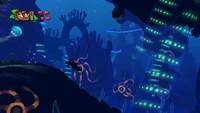
In Donkey Kong Country: Tropical Freeze, the type of darkness from Donkey Kong Country Returns reappears in only three levels: Busted Bayou, Amiss Abyss, and Cliffside Slide. Of these, the middle one is the most ambiently dark, being otherwise only lit by bioluminescent deep-sea creatures in the foreground and background, such as pyrosomes, brittle stars, and leafy seadragons.
Donkey Kong Land 2[edit]
In Donkey Kong Land 2, darkness returns in Glimmer's Galleon, though due to the absence of Glimmer, Light Barrels are used to light the stage instead.
Yoshi's Island series[edit]
Super Mario World 2: Yoshi's Island[edit]
In Super Mario World 2: Yoshi's Island, darkness appears in certain rooms of forts and castles. Piro Dangles are found in one such room, providing a small amount of light.
Yoshi's Island DS[edit]
In Yoshi's Island DS, darkness appears in a similar capacity as it does in the predecessor. Due to the generally lighter colors of the game, the darkness is also easier to see through.
Super Mario RPG: Legend of the Seven Stars[edit]
In Super Mario RPG: Legend of the Seven Stars, darkness appears in Bowser's Keep during the second visit, specifically the room immediately beyond where Mario fights Bowser in the first visit. A spotlight effect is used, though the surrounding areas can still faintly be seen. Enemies inhabit the dark here.
Mario Party series[edit]
Mario Party[edit]
In the Mario Party minigame Pedal Power, the player starts in a dark room and has to pedal a stationary bike to power a light and prevent a Boo from catching them.
Mario Party 2[edit]
In Mario Party 2, darkness is used in the Lights Out minigame. When the room occasionally becomes dark, only the players carrying lightbulbs remain visible.
Mario Party 4[edit]
In Mario Party 4, the Candlelight Flight minigame takes place in a dark room. The solo player carries a candle which becomes dimmer as the other three players spray water on it.
Mario Party 6[edit]
In the Mario Party 6 minigame Light Up My Night, darkness is used to obscure the candles within the maze. Dark 'n' Crispy also features darkness that veils Bowser.
Mario Party 7[edit]
In Mario Party 7, the Ghost in the Hall minigame has players navigate a dark maze-like mansion.
Mario Party 10[edit]
In Mario Party 10, it occurs in the minigame Murky Maze, wherein the players use Glow Blocks to navigate a dark maze.
Donkey Kong 64[edit]
In Donkey Kong 64, darkness appears a few times. In a hidden cave under Jungle Japes, a path is only lit by flaring torches that occasionally go off. Additionally, the shipwrecks in Gloomy Galleon are dark and lit by a Lightfish as a call-back to Glimmer in Donkey Kong Country 2: Diddy's Kong Quest.
Paper Mario series[edit]
Paper Mario[edit]
During Chapter 4 of Paper Mario, darkness is incorporated in the battle with the Big Lantern Ghost. While the Big Lantern Ghost is obscured in darkness, Mario and his partner are unable to attack him. In order to dissipate the darkness, they need to repeatedly hit his lantern. The Big Lantern Ghost is able to blow into his lantern, causing the room to become dark again.
The Big Lantern Ghost's room, the room preceding General Guy's room, the interior of the whale, the cave where the green member of the Fearsome 5 is trapped, and the cavernous room in Bowser's Castle are all dark. In order to illuminate them, Mario needs to use Watt's ability.
Super Paper Mario[edit]
In Chapter 7-2 of Super Paper Mario, the Underwhere Road, the dark obscures certain rooms. The dark is stylized as an animated scribble around the player character.
Paper Mario: Sticker Star[edit]
In Paper Mario: Sticker Star, the basement of one of the warehouses in Surfshine Harbor is obscured in darkness. The player must paperize and use a Lightbulb sticker to light up the room and reveal the Ship's Wheel.
Paper Mario: Color Splash[edit]
- “I wanna illuminate the darkness and all, but the light won't work...'cause there's no power... or something. I dunno. I'm not an electramatrician, bro. This darkness is really getting to me. It's, like, extinguishing the light in my heart...and stuff.”
- —Lighthouse keeper, Paper Mario: Color Splash
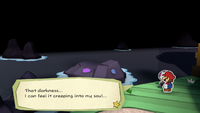
In Paper Mario: Color Splash, a solid wall of darkness obscures the world past Lighthouse Island. By fixing the lighthouse by using the cutout ability and placing a Lightbulb Battle Card, the lighthouse dissipates the darkness and reveals a Mini Paint Star in the process.
Paper Mario: The Origami King[edit]
- “It's too dark to see anything! Can't you flip the lights on? Somehow?”
- —Olivia, Paper Mario: The Origami King
In the Graffiti Underground, each floor is initially dark, preventing Mario from seeing past the entrance. He must hit the switches with his hammer to turn on the lights. The music in the area is also dynamic, being an arrangement of "Underground BGM" from Super Mario Bros. that only has the lead melody while the darkness is active, and adds the backing track once the room is lit up.
Luigi's Mansion series[edit]
- “Ghosts love to hide in dark places. Isn't that a hoot? There! Here they come!”
- —Professor E. Gadd, Luigi's Mansion
- See also: Blackout
In the Luigi's Mansion series, darkness represents rooms Luigi has not cleared out all the ghosts from. The original Luigi's Mansion also features a blackout event, where the power goes out and plunges the entire mansion into darkness, allowing ghosts to respawn indefinitely when rooms are revisited until the power is restored.
Super Smash Bros. series[edit]
In the Super Smash Bros. series, darkness occurs sometimes due to random effects from Togepi and Tingle. It also appears in the Battleship Halberd Interior stage of Adventure Mode: The Subspace Emissary of Super Smash Bros. Brawl, where temporary switches turn the lights on.
Super Princess Peach[edit]
In Super Princess Peach, darkness appears in Shriek Mansion. In the battle against King Boo, he is invincible until the darkness is lifted by lighting all the Lantern Ghost-shaped torches with Rage.
Mario & Luigi: Partners in Time[edit]
In Mario & Luigi: Partners in Time, darkness appears in certain passages where Baby Mario and Baby Luigi travel through. They are temporarily lit by a Shine Sprite spawned from an Adult Shine Block.
Gallery[edit]
Names in other languages[edit]
| Language | Name | Meaning | Notes |
|---|---|---|---|
| Japanese | くらやみ[?] Kurayami |
Darkness |
See also[edit]
References[edit]
- Hazardous objects
- Hotel Mario
- New Super Mario Bros. Wii objects
- New Super Mario Bros. U objects
- Paper Mario: The Origami King objects
- Super Mario Bros. 3 objects
- Super Mario Bros. Wonder objects
- Super Mario Maker 2 objects
- Super Mario Galaxy 2 objects
- Super Mario 3D World objects
- Super Mario 3D World + Bowser's Fury
- Super Mario World objects
- Super Paper Mario objects
- Mario Party 10
